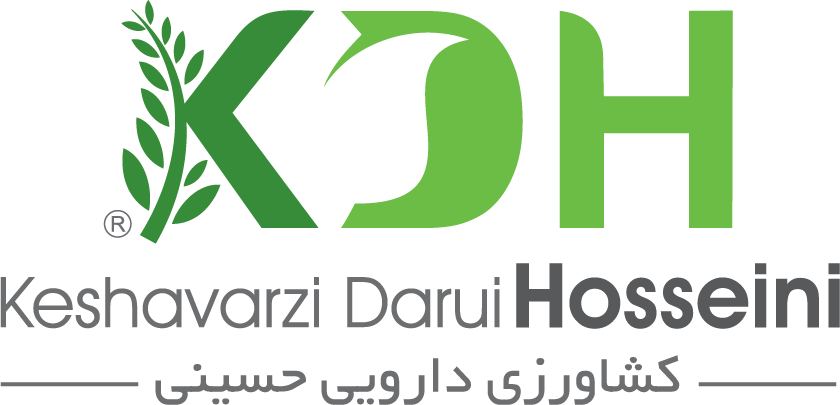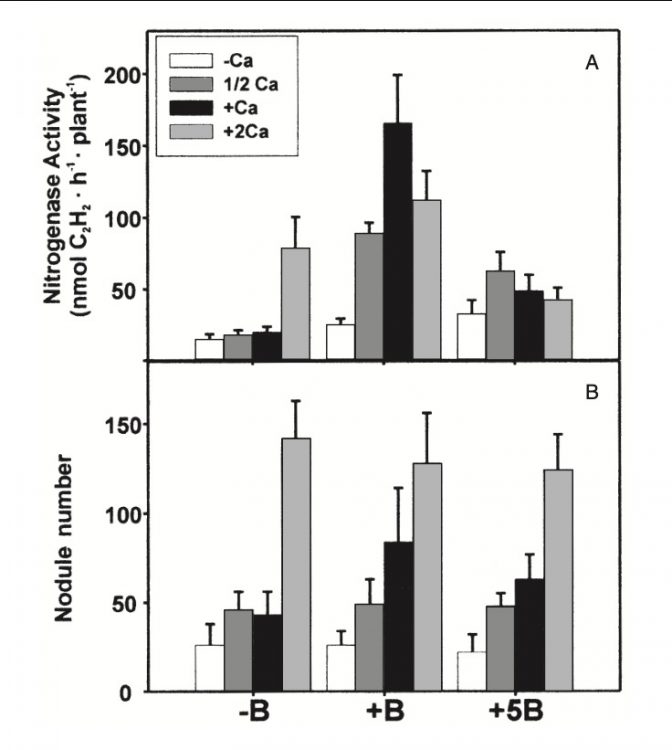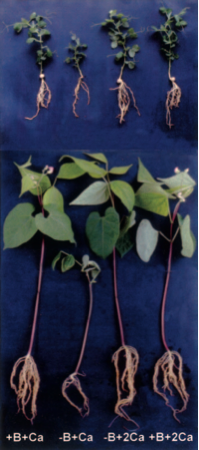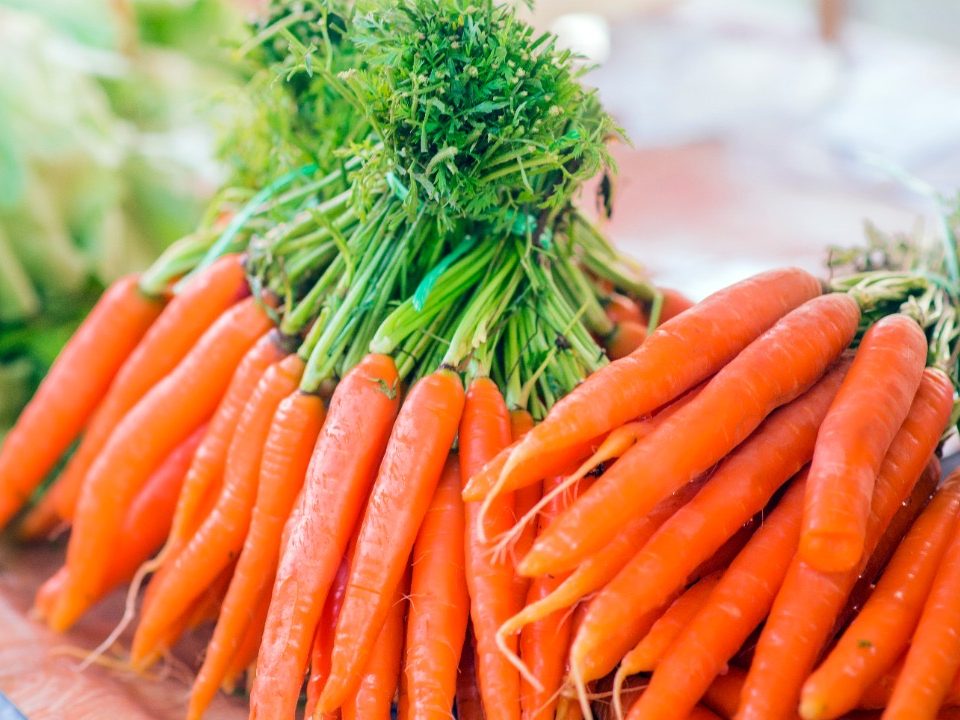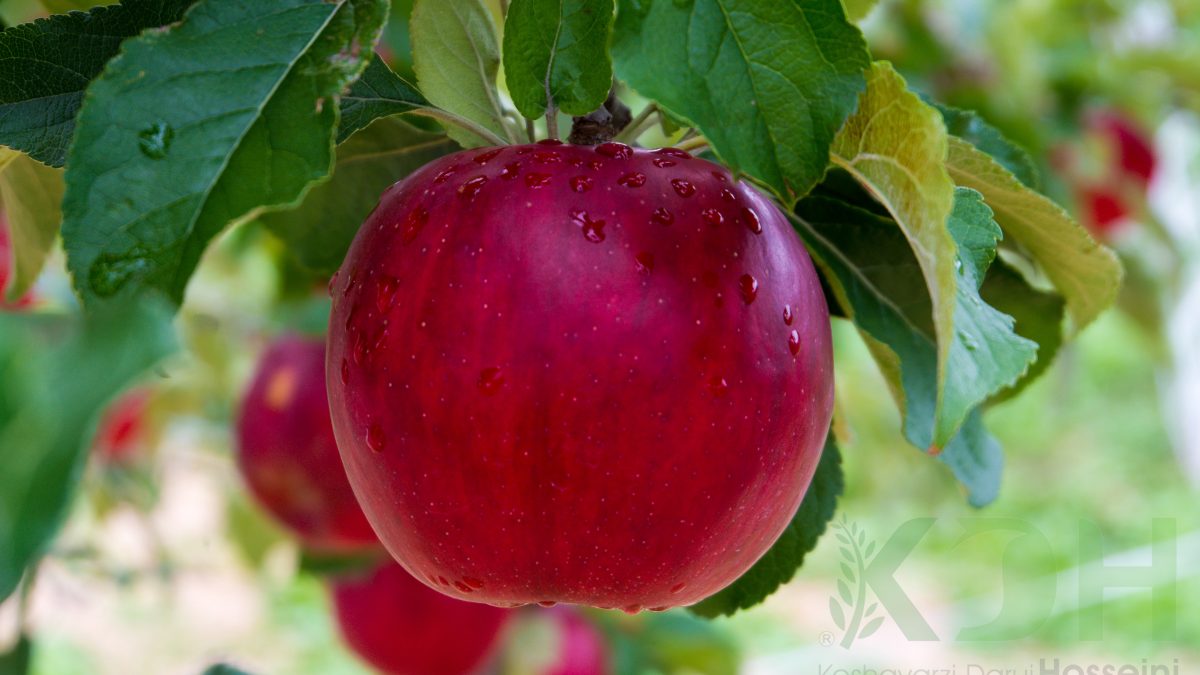
A review of the synergistic effects of calcium and boron
Improving crops quality and yield is due to the nutrient balance) Alloway, 2008.( The nutrients interaction is a factor for controlling the effects of excessive amounts of elements in the plant and also increasing plants efficiency. In this article, calcium and boron effects on plant growth and development, will be discussed.
Calcium is an essential plant nutrient and effective for the quality of agricultural products (Shobaky and Mohamad, 2000) and also, increases plant tolerance to stress, stimulates the activity of antioxidant enzymes and reduces lipid peroxidation (Khan et al., 2010; Siddiqui et al., 2010). Calcium involves in biochemical processes such as permeability and strength of cell wall, cell length and division, selective adsorption of other elements and also in pollen tube growth.
Calcium is the most abundant element in leaves, and is mostly used in cell wall formation. Calcium regulates protein pumps, that absorb nutrients into the roots and then transporting them to other cells (White and Broadley, 2003). The weakness of root system is due to calcium deficiency in comparison to other nutrients in irrigation water, and gradually causes root rot and even threaten sustainable production
Calcium deficiency symptoms, generally appear on plant’s cellular structure. We can refer to some disorders such as tomatoes blossom end rot (Figure 1), fruits softness and apple bitter pit (Figure 2), as calcium deficiency. Due to the similar effects of calcium and boron in the cell wall, deficiency of these elements are usually studied at the same time.
(Figure 1: Blossom end rot of tomatoes)
(Figure 2: apple bitter pit)
Boron is usually found in the form of boric acid in soil and washes away by heavy irrigation, easily (Yan et al., 2006). This element is essential for the optimal growth of plants for example in the metabolism of nitrogen, carbohydrates, nucleic acids, phenolic compounds, photosynthesis, enzymatic activity and defense mechanism. It is also effective for auxin production and its transition. Boron is essential for pollen tube formation, too (Marschner, 1995; Reid, 2010; Xuan et al., 2001).
Both boron and calcium are vital in cell wall structure. The optimal growth of plants is due to the balance between these elements. If one of these ions accumulates in the cell wall more than the other one, the other ion prevents toxic effects because of excessive deposition of that element.
In the case of boron deficiency, calcium absorption increases but, plant ability for transporting calcium decreases. Calcium and boron together increase calcium transition. The role of boron in increasing the solubility of calcium in plants is the reason for this topic. Deficiency of both boron and calcium alters metabolic pathways and increases the activity of phosphorylase, ribonuclease and polyphenol oxidase enzymes
In saline, low water and dry areas of Iran such as Kerman, Yazd, Qom and southern Fars provinces, the amount of boron in soil solution is very high. Boron toxicity is associated with symptoms such as chlorosis and necrosis in the marginal regions of mature leaves and structural damage to thylakoids thus, inhibits photosynthesis and ultimately reduces plant yield. Decreased boron toxicity can be explained by the accumulation of calcium in the cell wall (Turan et al., 2009). Calcium application can also affect the uptake and utilization of boron by plants (Kanwak et al., 2008) and moderate oxidative stress damages due to boron toxicity (Siddiqui et al., 2014).
The results of a study on the application of boron and calcium in Novell oranges showed that boron and calcium treatments were effective in increasing the percentage of final fruit set, fruit quality as well as average fruit weight and size, percentage of sugars and vitamin C (Hikal et al., 2017). Foliar application of boron and calcium in apples increased shoot growth, flowering, fruit set, size, firmness and storage time (Rab and Haq, 2012).
Calcium and boron have low mobility in the plant. The mobility of these two elements is affected by water absorption, evaporation and transpiration in the plant. Studies show that combined consumption of calcium and boron increases calcium mobility and accumulation in leaves and fruits. Application of calcium and boron together in legumes increases the number of nodes and their function (Figure 3) (Figure 4) (Redondo et al., 2003).
Figure 3: increase the number of nodes and function in application of calcium and boron
Figure 4: increase the number of nodes and function in application of calcium and boron
According to these studies, the most advanced fertilizer companies in the world, produce lots of their fertilizers based on calcium and boron elements and make them available for farmers.
Refrences:
Alloway, B. J. 2008. Zinc in soils and crop nutrition. IZA and IFA, France, 137p.
Shobaky, M.A. and Mohamad, M.R. 2000. Effects of calcium and potassium foliar application on leaves nutrients content, quality and storage life of citrus under drip irrigation in clay soil. J. Agric. Sci. Mansoura Univ, 25: 8027-8037.
Siddiqui, M.H., Mohammad, F., Khan, M.N., Al-Whaibi, M.H. and Bahkali, A.H.A. 2010. Nitrogen in relation to photosynthetic capacity and accumulation of osmoprotectant and nutrients in Brassica genotypes grown under salt stress. Agr Sci China, 9:671–۶۸۰٫
Khan, M.N., Siddiqui, M.H., Mohammad, F., Naeem, M.and Khan, M.M.A .2010. Calcium chloride and gibberellic acid protect linseed (Linum usitatissimum) from NaCl stress by inducing antioxidative defence system and osmoprotectant accumulation Acta Physiol Plant, 32:121–۱۳۲٫
White, P.J. and Broadley, M.R. 2003. Calcium in plants. Annal. Bot, 92: 487-511.
Yang, L., Li, G. Lin, Q. and Zhao, X. 2010. Active carbonate of chestnut soils in different lands. Ecol. Environ. Sci, 19: 428 – ۴۳۲٫
Marschner, H .1995. Mineral nutrition of higher plants, Academic Press, London.
Reid, R. 2010. Can we really increase yields by making crop plants tolerant to boron toxicity? Plant Sci, 178: 9–۱۱٫
Xuan, H., Streif, J., Pfeffer, H., Dannel, F., Romheld, V. and Bangerth, F. 2001. Effect of pre-harvest boron application on the incidence of CA-storage related disorders in ‘Conference’ pears. The Journal of Horticultural Science and Biotechnolgy, 76(2):133-137.
Turan MA, Taban N, Taban S. 2009. Effect of calcium on the alleviation of boron toxicity and localization of boron and calcium in cell wall of wheat. Not Bot Hort Agrobot Cluj 37.
Siddiqui M.H. Al-Whaibi, M.H. Sakran Hayssam, A.M. Mohammed, M.A. Basalah, O. Faisal, M. Alatar, M. Al-AmriA.A. 2014. Calcium-induced amelioration of boron toxicity in radish. J Plant Growth Regul, 33(1): 61-71.
Kanwak, S., Rahmatullah, A.T., Maqsood, M.A. and Abbas, N. 2008. Critical ratio of calcium and boron in maize shoot for optimum growth. J Plant Nutr, 31:1535–۱۵۴۲٫
Hikal, A. R. F. Ibrahim, M. A. and Abdelaziz, R. A. 2017. Effect of different treatments of calcium and boron on productivity and fruit quality of Navel orange fruits. Egypt. J. Hort, (44) 1: 119- 126.
(Figure 1: Blossom end rot of tomatoes)
(Figure 2: apple bitter pit)
Boron is usually found in the form of boric acid in soil and washes away by heavy irrigation, easily (Yan et al., 2006). This element is essential for the optimal growth of plants for example in the metabolism of nitrogen, carbohydrates, nucleic acids, phenolic compounds, photosynthesis, enzymatic activity and defense mechanism. It is also effective for auxin production and its transition. Boron is essential for pollen tube formation, too (Marschner, 1995; Reid, 2010; Xuan et al., 2001).
Both boron and calcium are vital in cell wall structure. The optimal growth of plants is due to the balance between these elements. If one of these ions accumulates in the cell wall more than the other one, the other ion prevents toxic effects because of excessive deposition of that element.
In the case of boron deficiency, calcium absorption increases but, plant ability for transporting calcium decreases. Calcium and boron together increase calcium transition. The role of boron in increasing the solubility of calcium in plants is the reason for this topic. Deficiency of both boron and calcium alters metabolic pathways and increases the activity of phosphorylase, ribonuclease and polyphenol oxidase enzymes
In saline, low water and dry areas of Iran such as Kerman, Yazd, Qom and southern Fars provinces, the amount of boron in soil solution is very high. Boron toxicity is associated with symptoms such as chlorosis and necrosis in the marginal regions of mature leaves and structural damage to thylakoids thus, inhibits photosynthesis and ultimately reduces plant yield. Decreased boron toxicity can be explained by the accumulation of calcium in the cell wall (Turan et al., 2009). Calcium application can also affect the uptake and utilization of boron by plants (Kanwak et al., 2008) and moderate oxidative stress damages due to boron toxicity (Siddiqui et al., 2014).
The results of a study on the application of boron and calcium in Novell oranges showed that boron and calcium treatments were effective in increasing the percentage of final fruit set, fruit quality as well as average fruit weight and size, percentage of sugars and vitamin C (Hikal et al., 2017). Foliar application of boron and calcium in apples increased shoot growth, flowering, fruit set, size, firmness and storage time (Rab and Haq, 2012).
Calcium and boron have low mobility in the plant. The mobility of these two elements is affected by water absorption, evaporation and transpiration in the plant. Studies show that combined consumption of calcium and boron increases calcium mobility and accumulation in leaves and fruits. Application of calcium and boron together in legumes increases the number of nodes and their function (Figure 3) (Figure 4) (Redondo et al., 2003).
Figure 3: increase the number of nodes and function in application of calcium and boron
Figure 4: increase the number of nodes and function in application of calcium and boron
According to these studies, the most advanced fertilizer companies in the world, produce lots of their fertilizers based on calcium and boron elements and make them available for farmers.
Refrences
Alloway, B. J. 2008. Zinc in soils and crop nutrition. IZA and IFA, France, 137p.
Shobaky, M.A. and Mohamad, M.R. 2000. Effects of calcium and potassium foliar application on leaves nutrients content, quality and storage life of citrus under drip irrigation in clay soil. J. Agric. Sci. Mansoura Univ, 25: 8027-8037.
Siddiqui, M.H., Mohammad, F., Khan, M.N., Al-Whaibi, M.H. and Bahkali, A.H.A. 2010. Nitrogen in relation to photosynthetic capacity and accumulation of osmoprotectant and nutrients in Brassica genotypes grown under salt stress. Agr Sci China, 9:671–680.
Khan, M.N., Siddiqui, M.H., Mohammad, F., Naeem, M.and Khan, M.M.A .2010. Calcium chloride and gibberellic acid protect linseed (Linum usitatissimum) from NaCl stress by inducing antioxidative defence system and osmoprotectant accumulation Acta Physiol Plant, 32:121–132.
White, P.J. and Broadley, M.R. 2003. Calcium in plants. Annal. Bot, 92: 487-511.
Yang, L., Li, G. Lin, Q. and Zhao, X. 2010. Active carbonate of chestnut soils in different lands. Ecol. Environ. Sci, 19: 428 – 432.
Marschner, H .1995. Mineral nutrition of higher plants, Academic Press, London.
Reid, R. 2010. Can we really increase yields by making crop plants tolerant to boron toxicity? Plant Sci, 178: 9–11.
Xuan, H., Streif, J., Pfeffer, H., Dannel, F., Romheld, V. and Bangerth, F. 2001. Effect of pre-harvest boron application on the incidence of CA-storage related disorders in ‘Conference’ pears. The Journal of Horticultural Science and Biotechnolgy, 76(2):133-137.
Turan MA, Taban N, Taban S. 2009. Effect of calcium on the alleviation of boron toxicity and localization of boron and calcium in cell wall of wheat. Not Bot Hort Agrobot Cluj 37.
Siddiqui M.H. Al-Whaibi, M.H. Sakran Hayssam, A.M. Mohammed, M.A. Basalah, O. Faisal, M. Alatar, M. Al-AmriA.A. 2014. Calcium-induced amelioration of boron toxicity in radish. J Plant Growth Regul, 33(1): 61-71.
Kanwak, S., Rahmatullah, A.T., Maqsood, M.A. and Abbas, N. 2008. Critical ratio of calcium and boron in maize shoot for optimum growth. J Plant Nutr, 31:1535–1542.
Hikal, A. R. F. Ibrahim, M. A. and Abdelaziz, R. A. 2017. Effect of different treatments of calcium and boron on productivity and fruit quality of Navel orange fruits. Egypt. J. Hort, (44) 1: 119- 126.
